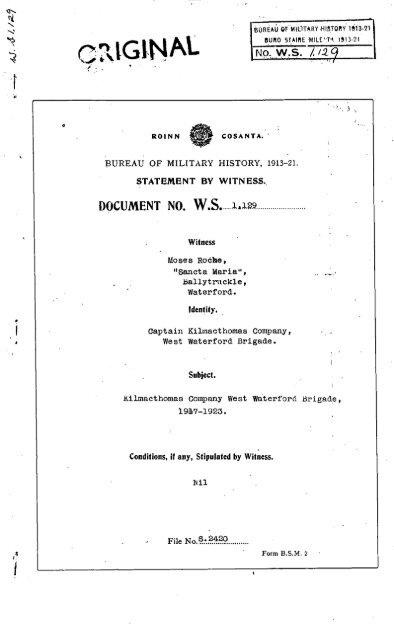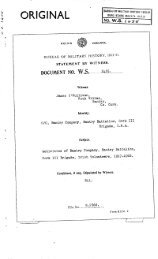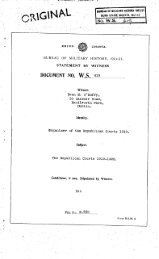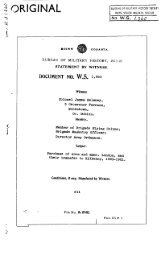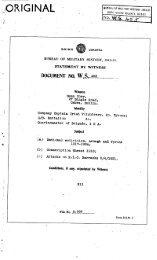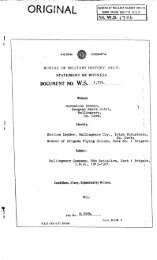CRIGINAL BUREAUOF MILTARYHISTORY1913-21 ...
CRIGINAL BUREAUOF MILTARYHISTORY1913-21 ...
CRIGINAL BUREAUOF MILTARYHISTORY1913-21 ...
- No tags were found...
You also want an ePaper? Increase the reach of your titles
YUMPU automatically turns print PDFs into web optimized ePapers that Google loves.
File No S.2420 Form B.S.M.2<strong>BUREAUOF</strong> <strong>MILTARYHISTORY1913</strong>-<strong>21</strong>BUROSTAIREMILEATA1913-<strong>21</strong><strong>CRIGINAL</strong>No. W.S. 1.129ROINNCOSANTABUREAU OF MILITARY HISTORY, 1913-<strong>21</strong>.STATEMENT BY WITNESS.DOCUMENT NO. W.S. 1,129WitnessMoses"SanctaRoche,Ballytruckle,Waterford.Maria",Identity.Captain Kilmacthomas Company,West Waterford Brigade.Subject.Kilmacthomas Company West Waterford brigade,1917-1923.Conditions, if any, Stipulated by Witness.Nil
ORIGINALSTATEMENTOF MOSES ROCHE<strong>BUREAUOF</strong> MILITARYHISTORY1913-<strong>21</strong>BUROSTAIREMILEATA 1913-<strong>21</strong>No. W.S. 1.129"Sancta Maria", Ballytruckle, Waterford.I was born in Doonane, Co. Leix, on 25. 11. 1900. Myfather, who was a native of Co. Cork, was an R.I.C. constablein Doonane at the time of my birth, and mywasaWaterfordwoman.On my father resigning from the R.I.C. in 1906, I movedwith the family to Waterford in that year where I attended the1ocal De La Salle Christian Brothers' School. I played thecustomary Gaelic games when at school and, at the age of 17,I went to the Waterford Technical School where I studied acommercialcourse.During the first World War 1914-18, I obained employmentas a machinist in the local munition factory, where ammunitionfor the British Governments, then at war with Germaay, was beingmade. In 1917, I was called to a job on the railway and tookup duty as a stationmaster's clerk in the Coaching Departmentof the then Great Southern and Western Railway WaterfordBranch.After the insurrection of 1916 probably early in 1917I joined the local unit of Fianna Eireann, the officers ofwhich were Tom McDonald, 0/C., Paddy Hearne, James O'Connor,Nicholas Brennan and a man named Walsh. It was as a memberof the Fianna that I got my first insight into the significancof the struggle for national independence which, for me atany rate, began with the 1916 Rising.During my early days with the Fianna in Waterford cityIhave a clear recollection of visits paid te us by the lateCountess Markievicz, and by Liam Mellows, both of whom talkedto us on the principles of nationality and strove to instilin our young minds a love of Ireland and a determination todo all in our power to help our country in her fight forfreedom.
2.My recollection of those Fianna days goes back to 1917-1918 when, in common with about 30 other young lads, Ilistened to lectures read from British military textbookson scouting, squad drill and suchlike. These lectures weregiven by our Vice 0/C. Paddy Hearn. I remember well thatmy great ambition at the time was to be able to purchase formyself a scout's uniform. In addition to the lectures givenby Paddy Hearn, we also received training in first aid. Atthe time there was a ladies auxiliary branch called a"sluagh" attached to the Fianna in Waterford, and it wasprincipally from members of that sluagh we got our first aidtraining.I was about twelve months or so in the Fianna when Ileft to join an organisation known as the 'National Guards'.This body was, so far as I can now remember, started inWaterford city by a man named McHenry who came down fromDublin. He was employed as cchef in the Imperial Hotel,Waterford. I am of the opinion that this McHenry Had somedifference of opinion with Countess Markievicz in Dublin onFianna matters and that he started this new National Guardsorganisation in Waterford as a sort of opposition to theFianna although the objects, of course, were quite the same.The 0/C. of the National Guards in Waterford was McHenryand one of his principal officers was a man named John,nicknamed "Bismarck" Power. There were about 40 members ofthis organisation in Waterford city, comprising mostly Fiannalads who considered the Fianna too juvenile and who were notconsidered old enough to join one of the local IrishVolunteer companies. An oath of allegiance to the IrishRepublic was administered to each member on his being accepteinto the National Guards. A copy of the oath was signed andretained by every member. I regret to say I have not now gotthe copy of the oath which I signed.
3.I remained a member of the National Guards organisationfor about eight or ten months only as I did not care much forthe type of recruits coming in by this I mean the type fromthe national point of view so I returned again to the localFiannaCompany.Sometime about late 1917, being anxious to a cquire someguns, were formulated by the Fianna to raid the store ofarms held by the Irish National Volunteers (John Redmond'sVolunteers) and kept in a store attached to the bakehouse ownedby a W.J. Smith in George's St., Waterford. There were,approximately, 500 rifles in this store and there was no guardwhatsoever placed on it. To us, this seemed a marvelouschance to lay our hands on some weapons which we were veryanxious to get hold of. I remember Paddy Hearn, who was secondin command of the Fianna, telling us that we should have theapproval of the 'heads' of the Irish Volunteers (who hadseceded from the National Volunteers) before taking any action.I remember quite well learning that the leaders of the IrishVolunteers refused to agree to the proposed raid, so we in theFianna did nothing further about the matter. The tragedy ofthe thing, from our point of view, was, that a very short timeafter our proposal had been turned down by the Volunteer leaderthese same guns were handed over to the British military byW.J. Smith, himself an officer in Redmond's Volunteers.Still being eager to acquire arms of any sort, we weretold by an old man of a quantity of arms and pikes which, hesaid, were hidden in an old Protestant churchyard at Bishop'sHall, Waterford. We carried out a search one night but foundthe spot caved in and nothing in it.During the famous 1918 by-election in Waterford, which wascontested by Dr. Vincent White on behalf of Sinn Fein, andCaptain William Redmond representing the Irish ParliamentaryParty, the Fianna did all the bill-posting and the painting ofslogans on walls and footpaths in support of Dr. White. On
4On one occasion we did this in the notoriously hostiledistrict of Ballybricken, Waterford, where the infamous pigbuyer crowd lived and who hated anything or anybody whoopposed the policy of John Redmond, the leader of the IrishParty in the British House of Commons.During the course of this bill-posting we were constantlyattacked and beaten up by the Ballybricken pig-buyer element,whose chief thug was a strong-arm man by the name of StephenLong. This man was not himself one of the pig-buyer fraternitybut seemed to be well-primed with money and liquor by themto carry out his blackguardly assaults on young lads, as theFianna were. On one such occasion, when we were beaten up andchased to the Volunteer Hall in Thomas St., Waterford, aVolunteer insi4e a New Ross man got a 32 revolver andwent out to tackle the Ballybricken element. Luckily for thelatter, they had just left the vicinity of the hall when theincensed New Ross man appeared on the scene.Usually this bill-posting was done during the night witha Volunteer guard, but we later dispensed with the latteras we found we could carry on much better on our own.During the 1918 election the Fianna acted as guide tothe Volunteers from outside areas who came in to Waterford tohelp in the election on behalf of Dr. White, the Sinn Feincandidate.I remember at the same time Eamon de Valera coming toWaterford. He and other men from the Sinn Fein headquartersin Dublin stayed in the metropole Hotel, Bridge St. Waterford.The Fianna paraded there to welcome him and their flag wascaptured by the Redmondite mob from Ballybricken and the ladsbeaten up. The flag was immediately retaken by a unit ofIrish Volunteers who, in addition to being assaulte4 withbricks and bottles by the opposition mob, was also subjectedto baton charges by the R.I.C. who invariably supported the
5.Redmondites in their attacks on republican sympathisers.On one occasion during the 1918 election, when the ballotboxes were being brought in to the Courthouse for counting ofthe votes, the R.I.C. surrounded the Volunteer Hall in ThomasSt. Waterford, and refused to allow anybody to enter or leavethe hail. I was in the hall at the particular time andremember a few rifle shots being fired from a house of a pigbuyer across the street into the Volunteers assembled in thehall. One Volunteer from Mullinavat, Co. Kilkenny, waswounded in the eye. I saw revolvers bring produced by some ofthe Volunteers in the hail that night, but no shots were firedby them, notwithstanding the treatment being meted out to them.Shortly after the General Election of 1918,Itransferredfrom the Fianna to A/Company, 4th Battalion, East WaterfordBrigade, Irish Volunteers. So far as I can recollect, the 0/C.was Willie Walsh (the G.A.A. referee). Other prominent memberswere J.D. Walsh (deceased), Sean Matthews and Peadar Woods.Willie Walsh was a clerk in Messrs. Phelan's sack and bagfactory where he still works. There were, to the best of myrecollection, about 30 men in the company and about two orthree revolvers, but I cannot be certain of that.At this time I was working in the parcels office of theGreat Southern and Western Railway in Ferrybank, Waterford,and took the opportunity of searching the luggage of Britisharmy officers passing through Waterford en route to FermoyBarracks and other military bases down south. These officerswere usually returning from the war in France and carriedrevolvers in their baggage. I am quite sure I must have gotat least 20 revolvers in this manner, together with a goodquantity of assorted ammunition. The guns were mainly longand short Webleys and a few of the 'bulldog' type. I wasassisted in this work by another Volunteer and a railwayemployee named Sean Brett. In addition to searching luggage
6.left in the office overnight, a railway platfqrm employeenamed Duignan used have a quick look through soldiers' kitleft lying around for an hour or so. In this manner wecollected quite a few German automatic revolvers being broughthome as souvenirs of the war by officers and British Tommies.Many a time we whipped the bayonets from rifles as they layunattended while the Tommies were out of sight, perhaps havinga drink in the railway bar. These weapons were all handed upto the late J.D. Walsh who as quartermaster of the citybattalion of the Irish Volunteers at that time.This went on without anybody suspecting that I wasinvolved in the disappearance of military equipment until oneday I spotted a British officer getting Off a train and leavinghis suitcase on the platform under the care of an R.I.C. man.When the officer had gone out of the railway station, theR.I.C. man went to have a meal, and I seized my chance toforce the lock of the case and run my hand through thecontents. To my great delight I came across a lovely newSmith and Wesson revolver and a pouch of ammunition. Withthe revolver in my pocket I actually passed the officer on myway to the parcels office where I worked, but I didn't knowhe was the man whose suitcase I had rifled, until a very shortwhile afterwards, when a terrible hullaballoo went up as theofficer discovered his loss.Meanwhile, in the short time at my disposal I hid therevolver and ammunition in 'bays' in the roof of the station.At once a search was carried out by British military. Everynook and cranny they could think of was searched for the missirweapon but to no avail. Att the railway staff were closelyinterrogated, myself, of course, included, but all deniedhaving anything to do with the officer's suitcase. Thesearching went on for a full week before the military withdre.Ab out two weeks later I took the revolver and ammunition
7from the hiding place and tried to smuggle it out to my home,but a detective officer named Organ was always on duty thereand I couldn't get through with safety. Eventually a railwaynight-worker named hennessy brought out the gun and left itin my home. As a result of my being suspected in connectionwith this revolver incident, I was transferred from Waterfordcity to kilmacthomas, Co. Waterford, railway station. Thedate was about December 1919.I was about two or three weeks in Kilmacthornas when Imade contact with a man named George Kiely, who was aVolunteer in that village. I admitted I had been a member ofthe Waterford City Battalion and, on hearing this, Kiely toldme he, too, was a Volunteer; in fact, he said he was the onlyone at that particular time in Kilmacthomas.Shortly after my conversation with Kiely I had an interviewwith the late Pat Keating (killed in action by Britishforces at The Burgary, Dungarvan, on 19th March 19<strong>21</strong>). Patwas commandant of the local battalion at the time. Thebattalion area covered the districts Comeragh, Kilrossanty,Kilmacthomas, Stradbally and Bomnahon, all in West Waterford,and was known as the 2nd Battalion, West Waterford Brigade.Pat Keating questioned me about the Waterford City I.R.A.officers, presumably to check on my bona fides. He asked meif I could obtain any guns and I told him I had two theSmith and Wesson revolver previously mentioned by me and a22 seven-chamber rimfire revolver. I brought these revolversout to Kilmacthomas and kept them myself, but loaned themout when required.As regards the strength of the Volunteers in Kilmaethomarthen (mid 1920) there was, in fact, no Volunteer company atall in thevillage, the numbers being too few to form aseparate company. The five or six members in the village wereconsidered an outpost of the Kilrossanty Company (ki1rossanty
8.is about five miles north west of kilmacthomas). Eddie Powerof Kilmacthomas was 1st Lieutenant of this outpost.Drilling took place in a district called Fews, abouthalf way between Comeragh and Kilmacthomas. Lectures onfirearms were given for which purpose I used bring my tworevolvers.Raiding for arms, which were very scarce with us, tookplace about the middle of the year 1920. Friendly farmhouses,as well as houses whose occupants were known to beunsympathetic to us, were raided and quite a good number ofshotguns and ammunition was collected. These guns were handedover to the Comeragh men whose battalion 0/C., the late PatKeating, lived in Comeragh. It was a simple matter to hideweapons in the mountain area of Comeragh.The strength of the kilmacthomas outpost grew to abouta dozen men as the year 1920 advanced, six or seven of whomwere, to the best of my recollection, armed with revolvers,the remainder with shotguns.About this period the cutting of telephone wires todisrupt enemy communication began; similarly, the blocking ofroads by felling trees. Raids on post offices in the districtwere carried out by Eddie Power and myself. We were masked(and armed) on these occasions as we were fairly wellknown formiles around Kilmacthomas. The mails were raided to obtaininformation from letters to or from R.I.C. men or theirrelatives, which might have some bearing on the strength ormovement of the I.R.A. in that district.I remember also that in 1920, on brigade instructions,a levy was made on farmers in the battalion area. This levywas calculated on the rateable valuation of the holding andwas collected by local Volunteers. The money so collected washanded over to a brigade nominee whose name I cannot now recalI cannot state with truth that this levy was paid up in every
9case without a protest; indeed it became necessary at timesto threaten certain people who objected to paying up. Thesepeople were, usually, those whom we knew were unsympatheticto our cause but, under threat, they paid up.I, personally, did a little work in 1920 relating to theDail Courts which were beginning to operate in West Waterford.I remember bringing men a ccused of offences to Stradbally,Co. Waterford, eight miles east of Kilmacthomas. The DailCourt at Stradbally was presided over bya local curate namedFather Shine. Men sentenced to imprisonment were sent to'gaol' and imprisoned in a house situated in the ComeraghMountains near to the village of Comeragh, about11/2 milesnorth of Kilrossanty. Many a night I mounted guard onprisoners there, returning to my work at Kilmacthomas railwaystation the following morning after handing over guard to somelocal Volunteers This house, known as "Scrubs" (or calledafter Wormwood Scrubbs internment camp in Wales), was oftenused by the West Waterford Flying Column in their activities,because of its remoteness and inaccessibilityIn August 1920, on the instructions of Eddie Power, sevenor eight of us left Kilmacthomas on foot at night and proceededin the direction of Kill about eight miles distant. I rememberbeing armed with a revolve. We halted about three miles westof the village of Kill, where we set about blocking the roadby felling trees and placing farm implements across the road.When we had the job done, the time was about midnight. Weremained at our position as instructed for about an hour duringwhich we heard firing and saw Verey lights being fired intothe sky in the direction of the village. One of our men thencame down the road from Kill and told us the police barrackshad been attacked and that we should disperse as the plannedattack was over because of the arrival on the scene of a largebody of British military. We withdrew as ordered, but I can
10.definitely state that no military approached Kill from ourposition; neither did we encounter any enemy forces that nighton our way back westward to Kilmacthomas.In the autumn of 1920, so far as I can remember, I wasasked by Eddie Power to go with him to ambush troops expected(from Dungarvan) to raid the house of Ned Power of Glen,Kilmacthornas, a brigade (or battalion) officer. We reacheda spot at Kilminnion Bridge which is about eight miles east ofDungarvan and on the coast road, late at night. When we gotthere, we met the West Waterford Brigade 0/C., Pax Whelan,the Vice 0/C. George Lennon, and about 15 men armed with rifles"Nipper" McCarthy was there carrying bombs. Andy Kirwan ofBoat Strand, Bonmahon, the column motor driver, together withNed Power of Glen, the man whose house was to be raided by theBritish, were also there. I was armed with my own Smith andWesson revolver and about a dozen rounds of ammunition.Eddie Power and I were placed in position on a heightover-looking the bridge on the Dungarvan (west) side. On our leftwere about five riflemen and others with hand grenades. AndyKirwan with about six riflemen and shotguns men was in positioron a grass covered big rock at the Stradbally (east) side ofthe bridge. We were all set to give the British a hotreception, but, although we waited until after 2 o'clock inthe morning, the enemy didn't turn up and we got orders todisperse.When Eddie Power and myself reached Kilmacthomas afterthe abortive attempt at ambush at Kilminnion, we found thatthe military had been there searching during the night. Theyhad actually brought the inhabitants of the village out on tothe street in their night attire. They were looking for NedPower of Glen, but apparently mixed the name Eddie Powerof Kilmacthomas, and that was why we missed them at KilminnionBridge; they had gone to Kilmacthomas in error.
11.About the same time, George Lennon, Brigade Vice 0/C.,Mick Shalloe and Jim Pender, all of Dungarvan, sent for meand said we were going to 'have a go' at a military lorryexpected to pass through Kilmacthomas. Lennon and Shalloe hadgrenades to drop into the lorry, but although we waited morethen two hours on the railway bridge under which the road ran,no lorry came along.Sometime early in the year 19<strong>21</strong>, I remember being calledto do armed guard duty in the Comeragh district. It appearedas if something big was on foot, as brigade officers werecoming and going all night. I was on guard for two consecutivenights on a house in the Comeragh mountains, but who was thereor what was happening I do not know to this day.It was early in the month of March 19<strong>21</strong>, when I receivedinstructions to block the main Dungarvan-Waterford road byfelling trees. In company with a few local Volunteers, Icarried out this task which, I remember, finished at aboutone o'clock in the morning, after which I returned tokilmacthomas.The morning following the blocking of the road, when Iwas on duty at kilmacthomas railway station, I was told by thestationmaster that a train had been held up and stopped atDurrow on its journey to Waterford by a party of armed menand that I was to carry out the duties of pilot. This meantthat I would have to walk the railway line from Kilmacthomasto Durrow, report for duty to Durrow and verify that the linewas clear. I was then to travel up and down on each trainbetween Kilmacthomas and Durrow until such times as the signallines between the railway cabins had been repaired (theselines had been damaged to disrupt train communications) andthe staff instruments put in order.I left Kilmacthomas in the forenoon and walked along theline until I met the train about six miles to the west. The
12.The train was stationary and had the fireman only on her engineThe fireman's name was Jack Edwards, afterwards shot in Kilkenngaol during the civil war. He was a member of one of theWaterford city companies of the I.R.A. The passengers wereall sitting along the railway embankment and when I askedEdwards about them he told me these people were mostly jurorson their way to Court in Waterford. Edwards also told me thatan ambush was being prepared by our lads in the vicinity ofwhere the train was stopped, in anticipation of British forcescoming on the scene, when word reached them of the train hold-upI continued along the railway line until I reached Durrowstation about another two miles distant, when I was arrested bythe officer in charge of a party of British troops who hadoccupied the station premises a short time before my arrival.He asked me about the train hold-up and I remember telling himthat I had only come upon the train in the course of my dutiesas pilot man and that I had neither seen nor heard of any armedmen in the neighbourhood.The British officer did not seem to be quite satisfiedwith my story because he, thereupon, ordered me at the pointof his revolver to lead the way by a detour across country tothe point where the train was held up. As we came closer tothe train, the officer compelled me at revolver point to standup on each ditch as we met it to see if there were armed menaround, at the same time warning me that on the first sound ofa shot being fired at his men he would shoot me instantly.My position then was an unenviable one. If I refused to climbon a ditch, or if the ambush, which I knew was laid, began,I would certainly have been 'plugged' at once by the British.As I approached the stationary train, the officer spotted thejury men sitting along the embankment and prepared to open fire.thinking the jurors were I.R.A. men. It was only with thegreatest difficulty I convinced him that the men were really
13.jurymen and not, as he imagined, a number of I.R.A. waitingin ambush. Luckily for me, no ambush did occur at that time(about midday) and I was released by the military, whereuponI returned to kilmacthomas. Some weeks or so afterwards,I learned that one of our lads who had been lying in ambushnear Durrow station on the occasion of the train hold-uphad seen me walking in advance of the military and standingup on a ditch. He had trained his rifle on me, but as I camenearer to his position, he recognised me and held his fire.He was very puzzled to know what on earth I was up to andlaughed afterwards when I told him of the predicament in whichI found myself.The Saturday prior to the ambush at Ballyvoile, Co.Waterford, which, so far as I can recollect, occurred aboutthe end of April 19<strong>21</strong>, I received a 'phone message to therailway cabin at Kilmacthomas station to meet the boys atDurrow station and bring all the weapons and ammunition Icould lay my hands on. I got myown Smith and Wesson revolverwith some ammunition and filled my pockets with an assortmentof shotgun cartridges. A man named Skehan of Kilmacthornasdrove me in his pony and trap towards Durrow, where we metup with about 10 men from the nearby Stradbally Company.I left my revolver with one of the Stradbally men and droveon to the house of Jack Power of Glen, about two miles fromDurrow. Jack told me that military patrols were out all overthe area and, on hearing this, I dumped all the ammunitionI had behind a stone in a ditch. It was about 9 p.m. now andthe night was very dark.A short distance from Power's house I was halted bymilitary at a crossroads, taken from the pony and trap andsearched, as was Skehan the driver. The latter had some drinktaken and was in a hilarious mood, which fact was very likelyresponsible for the military not paying too much attention
14.to us when I explained we were just "having a night out".However, we were ordered to follow the advance guard of military.in the pony and trap. On the way I turned the trap up anarrow lane and, in the darkness of the night, eluded therearguard of military, who didn't notice what had happened.With regard to the subsequent engagement at ballyvoileBridge in the early hours of the following morning, to thebest of my recollection, there were at least 30, if not 40,of our men in position waiting to ambush a cycling patrol ofmilitary expected to pass that way. Jack Tobin, vice-comdt.of the 4th (kilrossanty) Battalion, was in charge. The ambushturned out to be a fiasco. It appears that one of our scoutswas seen crossing a road by the military in the early hoursof the morning, with the result, that the officer in chargeof the British got suspicious, and, as it so happened, didnot proceed with his men into the ambush position. Instead,he fired a shot from his revolver to which one of our menreplied, thereby giving away our position to the enemy. Thelatter started an outflanking movement on our men and, beingbetter armed, forced us to retreat. In the encounter which,so far as I can remember, lasted about 20 minutes or so, JohnCummins of the Stradbally Company was killed, and JohnMansfield of Kilmacthomas wounded. I cannot say whatcasualties, if any, were suffered by the British.Shortly after the Ballyvoile engagement I went on a briefholiday to Newcastlewest Co. Limerick, but I was arrested inLimerick and put in a train with other civilians by a Britishofficer who was taking a regiment on to Tralee. The officerinformed us that we were being taken as hostages in case thetrain was ambushed on its journey to Tralee, and that we wouldbe shot if his troops were attacked en route. No ambushoccurred and I was released on arrival in Tralee.
15.I returned to kilmacthomas after a week or so, the timebeing about the end of May 19<strong>21</strong>, and reported for duty to therailway station. I then learned that a regiment of Britishtroops the Yorks and Lancashires had occupied kilmacthomasPoor law Union buildings with two field guns as part of theirarmament. Their patrols were very active in the area, one ofwhich called on me at the railway to inquire my address inkilmacthomas. Subsequently, soldiers used to call at my 'digs'very frequently at night, sometimes about 9 p.m. and againabout midnight to see if I was on the premises. On everyoccasion they insisted on seeing me in person, to satisfythemselves I was really there.I put up with this sort of thing for a few weeks whenI decided to clear out of Kilmacthomas, give up my job at therailway and join the West Waterford Flying Column under PaxWhelan, which was then (June 19<strong>21</strong>) located on the Comeraghdistrict. I did get to Comeragh and met the column, but asI had at the time only an old shotgun, it was decided that Ihad better return to the company area and keep things goingas best I could there.I was appointed a full company captain in early June 19<strong>21</strong>with Michael Hill, Kilmacthomas, as 1st Lieutenant, and JohnKirwan, Fews, Kilmacthomas 2nd Lieutenant. The adjutant wasa man named Edward Doohan and the quartermaster William Powerof Graignarush, Kilmacthomas.This was the position when the Truce came in July 19<strong>21</strong>.During the Truce period I organised billets for acompany officers' course in training conducted by Paddy Paul,the brigade training officer for the Waterford Brigade. About50 men attended at Graignarush just outside kilmacthomas wherethe camp was held. Following the course, an examination washeld at which I obtained second place. As a result 1 was
16.asked to take over the training of the 2nd Battalion(Kilrossanty) Waterford Brigade. I should have stated earlierthat sometime in Mid-June 19<strong>21</strong>, the East and West WaterfordBrigades were amalgamated and known as the Waterford Brigadeunder the command of Pax Whelan, Dungarvan, Co. Waterford.Later in the year 19<strong>21</strong> about August or September Iwas attached to what was known as the Brigade Maintenance PartyThis comprised about 6o to 80 men and was quartered in billetsat Ballinacourty Co. Waterford. This force was used in themaintenance of law and order generally in the brigade area,and was under the command of Paddy Paul, Brigade TrainingOfficer.Following the evacuation of barracks by British troopsand R.I.C. early in January 1922, I took over charge of PortlawR.I.C. Barracks with a party of men from the 2nd Battalion areaand, about the same period, took part in a hold-up of Blackand Tans and R.I.C. at Dunkitt Co. Kilkenny, about two milesnorth of Waterford city on the main Waterford-Kilkenny road.Information reached us from a friendly Black and Tanthat a convoy was proceeding to Gormanston Camp, Co. Heath,for disbandment and that the convoy would consist of about80 armed R.I.C. and Black and Tans in Crossley tenders with alancia armoured car. About 30 of us selected for the job ofholding up the convoy were assembled in Ballinacourty, givendetails of what was to be done and told that on no accountwere shots to be fired, as it was expected that the job couldbe carried out without incident, according to what the friendlyBlack and Tan told us. Besides, the Truce was on and'no shooting' was the 'order of the day'.Our party proceeded in motor cars to the appointed placeat Dunkett and placed a barricade across the main road. Wethen lined the fence at both sides of this barricade and
17awaited developments. The convoy came along in due courseand stopped at the barricade. We shouted: "Put them up, ye areall covered". A Black and Tan (probably the man who hadgiven us the tip off) shouted: "Stop, boys, they are toomany for us". I remember these words quite well. All themen in the convoy dismounted and put up their hands. Theyput up no opposition.We seized the Crossley tenders with cases of ammunition,rifles, machine guns, revolvers and grenades. The Lanciaarmoured car was also taken and all the enemy cars were mannedby our own drivers and driven up to comeragh in the mountainswhere the captured stuff was carefully hidden. The Black andTans and R.I.C. were taken in a few tenders to portlaw wherethey were told to get out. A van was commandeered by themwhich they used to get to their destination.This raid I speak of was, of course, unofficial, but itwas considered that such a grand opportunity of getting fromthe British such a large quantity of weapons and ammunitionwith such little trouble was something which should not bemissed.When the British evacuated the infantry barracks inWaterford city early in 1922, I was one of the I.R.A. partywho took over the barracks where I remained as adjutant untilthe Free State troops attacked Waterford later in that year.I took part in the defence of Waterford and, after itsoccupation by the Free State army, I retreated west towardsDungarvan where I served with an active service unit underThomas Keating of Comeragh, who was killed in the subsequentfighting. in Co. Waterford.This a ctive service unit operated in the area betweenDungarvan and Waterford. city during which we attacked TramoreCoastguard station with myself in charge whilst the main bodyof the column attacked a Free State military post at Whitfield
18.about four miles west of Waterford.We returned again to Kilrossanty district where wewere attacked by vastly superior numbers of Free State troopsat Barnakill near Kilrossanty. Following this engagement,Thomas Keating, Jack Tobin of Cappoquin, myself and othersof the column attacked troops stationed in kilmacthomasWorkhouse. In the late autumn of 1922, myself and a fewof the column were captured in a farmhouse at Ballylinch,about six miles south-west of kilmacthomas, the date was15th October 1922.I was imprisoned in Kilkenny Gaol and was latertransferred to Hare Park Internment Camp at the Curragh,Go. Kildare, from where I was releasedin 4- 4- 24.Signed: Moses Roche(Moses Roche)Date: 17th March 195517th March 1955.Witness: T. O'Gorman(T.O'Gorman)<strong>BUREAUOF</strong>MILITARYHISTORY1913-<strong>21</strong>BUROSTAIREMILEATA1913-<strong>21</strong>No.W.S.1.129


